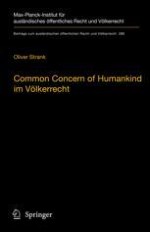2019 | OriginalPaper | Chapter
VII. Die älteren Wurzeln des Begriffs common concern
Author : Oliver Strank
Published in: Common Concern of Humankind im Völkerrecht
Publisher: Springer Berlin Heidelberg
Activate our intelligent search to find suitable subject content or patents.
Select sections of text to find matching patents with Artificial Intelligence. powered by
Select sections of text to find additional relevant content using AI-assisted search. powered by
